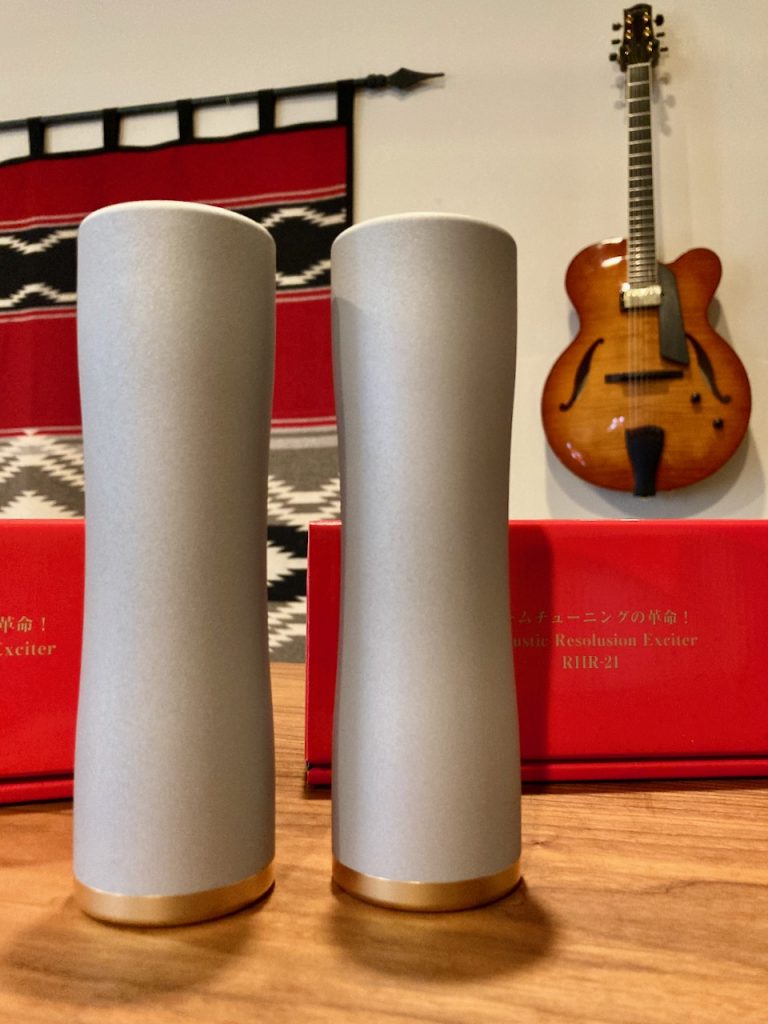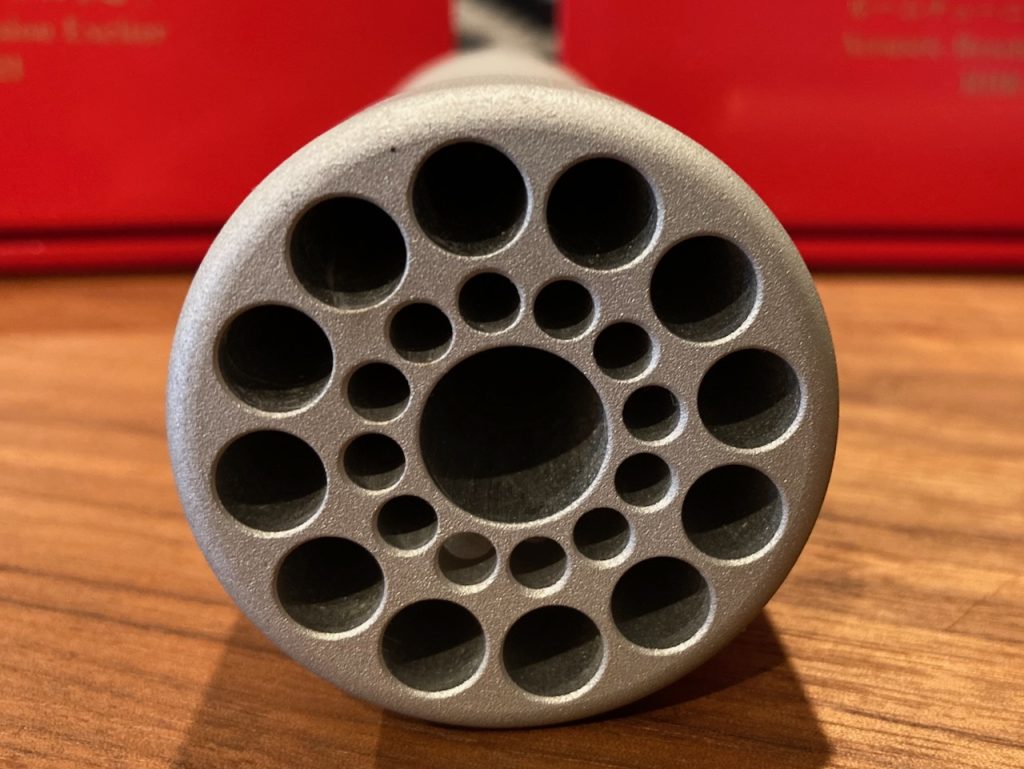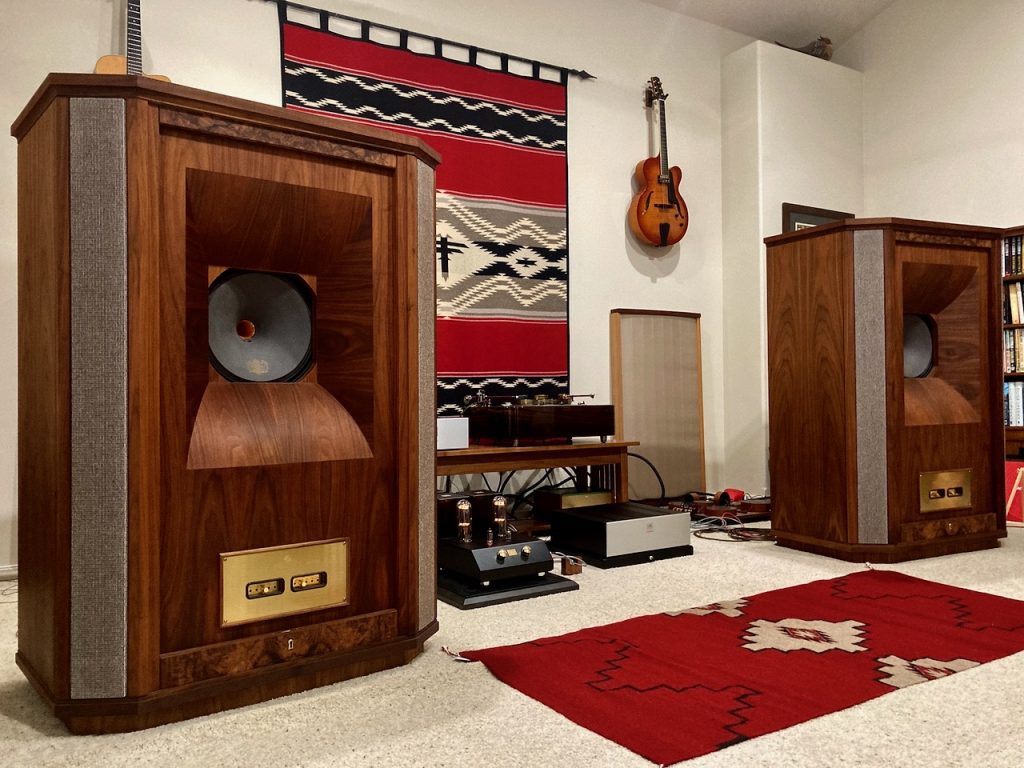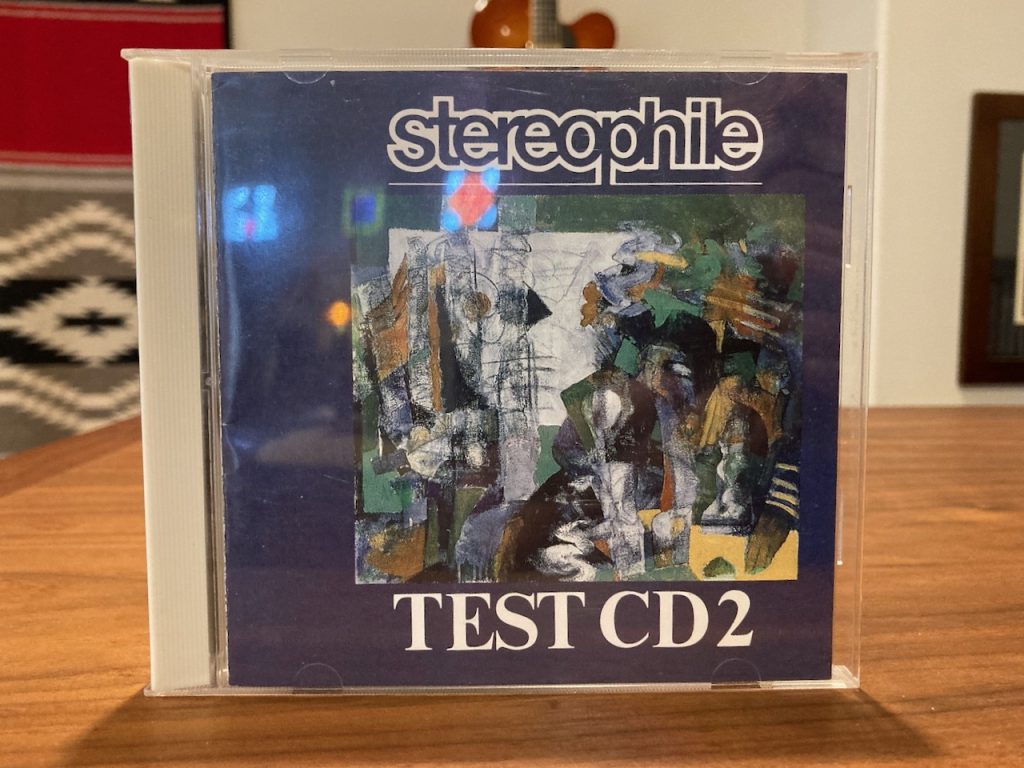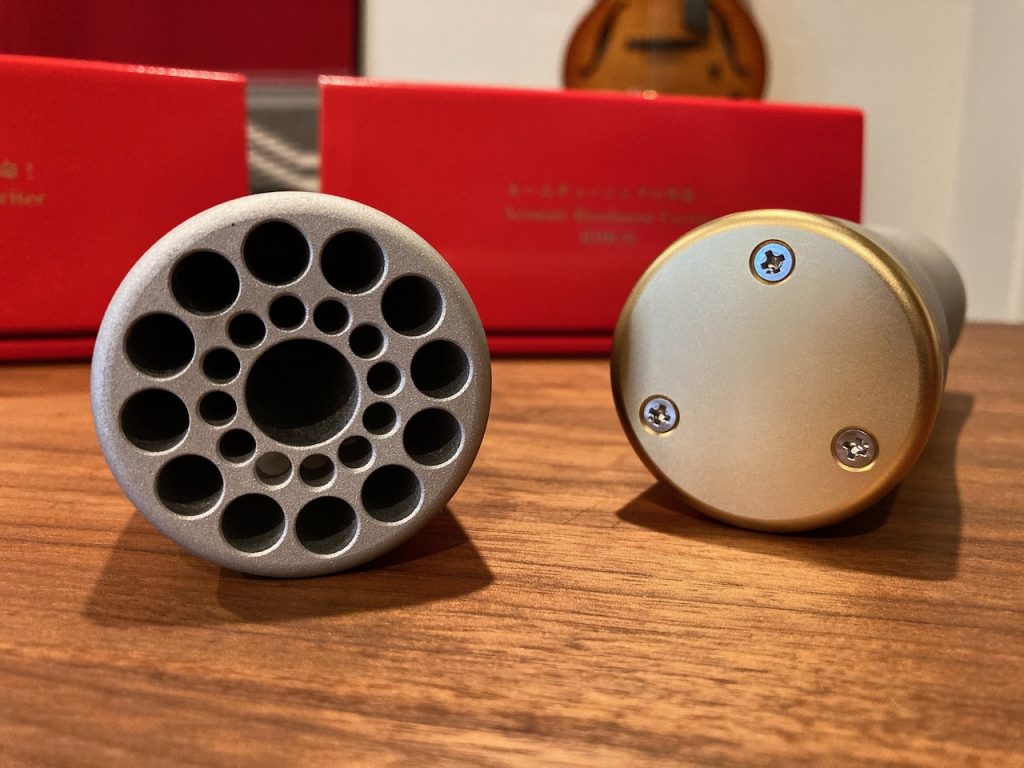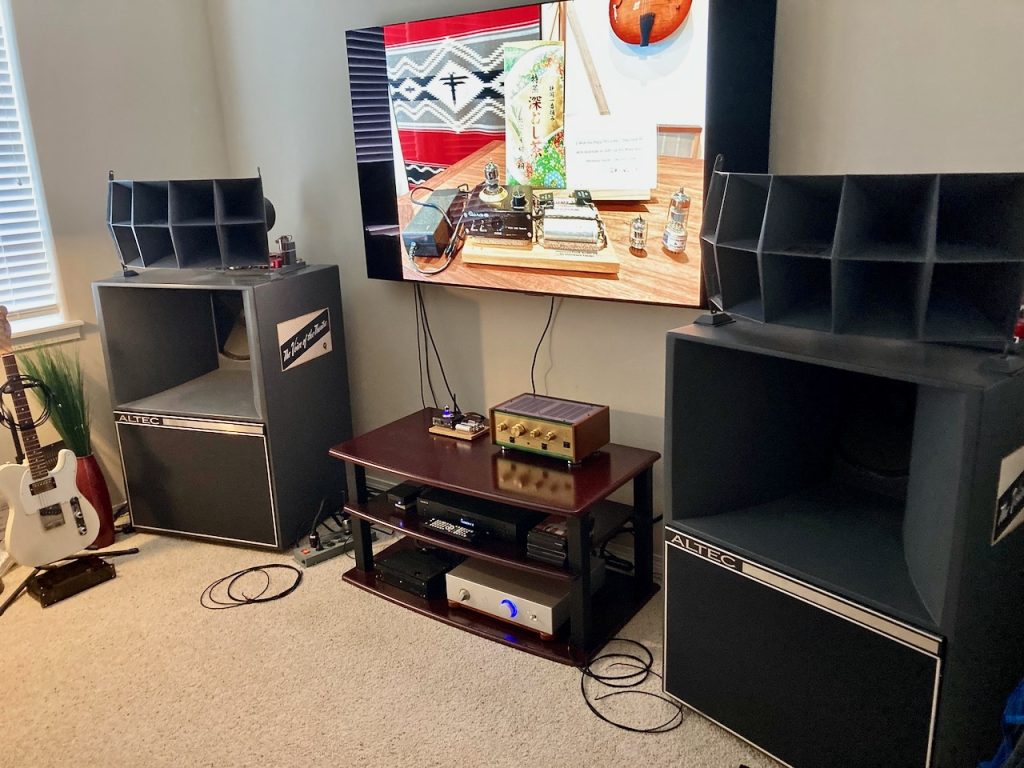The Acoustic Revive RHR-21 Acoustic Resolution Exciters are based upon the principle of Helmholtz resonance (HERE).
I was not familiar with Helmholtz resonators and their applications, so I decided to look into them a little more before doing any more listening with the RHR-21 Helmholtz resonator room tuning devices - I wanted to understand how they worked.
To quote from the article linked above, "Helmholtz resonators consist of a cavity or chamber with a small neck or opening that connects to the main sound source. When a sound wave enters the cavity, the resonant frequency of the neck and the cavity combine to amplify or attenuate the sound wave. The amount of attenuation depends on the size and shape of the cavity, the size of the neck, and the frequency of the sound wave."
Helmholtz resonators are typically used to attenuate low freuqency noise. Helmholtz resonators are used in mufflers for internal combustion engines to attenuate engine noise, to reduce noise in HVAC systems, to control sound reflections in concert halls and recording studios, to create acoustic filters, and to improve acoustic comfort in noisy office spaces, for example.
The RHR-21 combines 25 Helmholtz resonators in a single chassis.
I reported in Part 1 that during casual music listening with my Tannoy Westminster Royal SE based audio system that I didn't hear any noticeable difference when using the RHR-21s.
When I did more focused listening while positioning the RHR-21s in the various positions recommend by the Acoustic Revive User's Manual, I reported my subjective impressions about how I thought the RHR-21s affected sound quality when playing music.
Given that I was not hearing what Helmholtz resonators are noted for - low frequency attenuation - I was puzzled.
What I thought I was hearing were more like changes in the presence frequency range (4 kHz to 6 kHz), which really didn't make sense to me from a Helmholtz resonator perspective.
I don't have a sophisticated way to measure SPL changes covering all the frequencies from 20 kHz to 20 Hz of the audio spectrum, but I thought I'd try some very basic measurements using an SPL meter and the Stereophile Test CD 2 that has a series of 1/3 octave warble tones that cover a bass decade (200 Hz to 20 Hz), midrange decade (250 Hz to 2 kHz), and treble decade (2.5 kHz to 20 kHz) of frequencies (see photo below).
First I recorded several baseline SPL measurements for each track in a spreadsheet without any RHR-21s positioned in my room. I estimated the error bars to be about +/- 2dB for my measurements.
 Then I positioned one RHR-21 as described in the manual (above) and measured the SPL measurements for each frequency track.
Then I positioned one RHR-21 as described in the manual (above) and measured the SPL measurements for each frequency track.
There were no significant differences at any of the frequencies of the Stereophile Test CD 2 in the bass decade, midrange decade, or treble decade when using one RHR-21.
I then repeated the process using two RHR-21s as described in the owner's manual.
The results showed no significant differences at any of the frequencies of the Stereophile Test CD 2 in the bass decade, midrange decade, or treble decade when using two RHR-21s.
My subjective impressions of not hearing any changes in the low frequencies matched the measured data for the bass decade.
However, my subjective impressions of what I was hearing in the presence frequency range (4 kHz to 6 kHz) were not reflected in any of the measured data. Yet my subjective impressions were the same through multiple trials.
So here we have a collision of subjective performance perceptions and measured performance in the presence region of the audio spectrum.
So in this particular room, for this particular audio system, the measured data showed no difference in performance with one or two RHR-21s in the system.
Other RHR-21 users - including recording studios - have reported significant improvements from using the RHR-21s in their rooms.
In my listening room there were no measurable differences using the RHR-21s, although I repeatedly heard changes in spatial characteristics during subjective listening when using them. I'm not sure what to make of that.
UPDATE
I have always been impressed with the results I've achieved with Ken Ishiguro's Acoustic Revive audio accessories, and look forward to reporting about them.
The Acoustic Revive audio accessories have delivered superb results for me, and if you look closely in the accompanying photos, or in my review articles for Positive Feedback where I detail the audio accessories used, you'll know I use quite a number of them on a daily basis in my audio systems: wall outlets, power cords, isolation platforms, acoustic panels, and so on. They work as advertised to improve my audio system's performance.
The RHR-21s are a relatively new and important accessory for Acoustic Revive, so not achieving the sorts of results in the bass region that I was expecting - and other RHR-21 users were experiencing - was a surprise for me. I am of course dismayed by that because it makes for an awkward report when results don't go as expected.
Not to give away the story, but I think I have figured out why, and it's not the fault of the RHR-21s.
I want to point out that while I didn't hear any change in the measured low frequencies, I did hear significant changes in certain aspects of performance when using RHR-21s as I reported in Part 1 of my subjective listening sessions.
My listening impressions were mostly related to how the RHR-21s changed the spatial nature of the soundstage, which they affected significantly. For those who are interested in experimenting with or maximizing the spatial nature of the soundstage, and imaging localization within the soundstage, the RHR-21s worked quite well, and are worth investigating.
I contacted Yoshi-san (exporter) and Ken-san (manufacturer) about not being able to achieve the expected results with the RHR-21s in the bass region, and we have been trying to sort through any possible issues that might be involved with my room, audio equipment, my use of the RHR-21s, or anything else we could think of.
Here are the comments exchanged between Ken-san, Yoshi-san, and myself as we were trying to troubleshoot the situation:
From Ken-san: "RHR-21 is effective also at low frequencies, but it absorbs(articulates) sound evenly from low to high frequencies, so if you only focus on eliminating standing waves in the low frequencies, you may be disappointed. RHR-21 is of course effective against standing wave-like stagnation in the low frequency direction, but it does not have the great effect of absorbing standing waves like a large resonant tube (such as a tube trap product)."
From Jeff: I think Ken-san hit upon something important here regarding standing waves. I was disappointed that I didn't hear any changes in the low frequencies, but it may simply be the case that there were no standing waves to eliminate in the low frequencies, which would explain why I didn't hear any difference in the low frequencies when using the RHR-21s.
From Ken-san: "The biggest effect of the RHR-21 lies not in the improvement of frequency characteristics (though of course there is an effect), but in the improvement of "phase characteristics" and the improvement of timbre and texture. This will definitely be effective if placed behind the left and right speakers. Even if you move the distance and position behind the speaker, the effect and size will change."
From Jeff: I did hear differences in audio performance using the RHR-21s during subjective listening, which I described in Part 1, which I will briefly restate in a moment.
From Ken-san: "First, let's take a look at what's symptoms of concern about the current listening room at Mr. Jeff Day's house (before using the RHR-21).
- Is it a standing wave in the low frequency direction?
- Is it a flutter echo in the mid-high range?
- Is it phase or localization?
Please try again by focusing to such the symptoms."
Comments from Jeff:
Standing waves: I do not have concerns in my room about standing waves, and I don't think that is a factor based on frequency-SPL measurements I have performed, with and without the RHR-21s being present in the room.
Flutter echo: Flutter echo is something I haven't really thought about before. I had to look up the definition (from the Acoustic Surfaces website HERE):
"An echo flutter occurs when sound energy is trapped and continuously bouncing between two parallel surfaces in a repeating loop, producing a series of rapid sound reflections in short time signatures. It's most commonly found in spaces with hard reflective walls."
My living room area serves as my primary listening room (it is 27’6’’ long by 20’4’’ wide, and with variable cathedral ceiling height from 9 to 20 feet). The front & rear walls are irregular, as are the sidewalls, and any large surfaces are covered with wool wall hangings to damp reflections. Directly behind each loudspeaker I have one Acoustic Revive RWL-3 acoustic panel, and one RWL-3 located on the rear wall about 12 feet behind my listening position. The floor of my living room is carpeted and not reflective.
After reading the definition about the cause of flutter echo I do not think this is an issue in my room, nor do I hear anything that would indicate the presence of a flutter echo. With the irregular nature of my room, and the sound treatments that are already in place, its seems that flutter echos are unlikely.
Phase: From a phase perspective, when a loudspeaker is placed near a reflective surface, the sound coming from the loudspeaker and the sound reflected off the wall can arrive at the listening position out of phase from cancellation or reinforcement effects.
I use a typical audiophile rule of thirds/fifths positioning strategy for my loudspeakers in my living room, which positions the loudspeakers well away from walls and reflective surfaces: from the cabinets' closest surfaces to the walls, the loudspeakers are 55 inches from the front wall, 49 inches from the sidewalls, and about 21 feet from the rear wall. The loudspeakers are about 9.5 feet apart measured center-to-center. My listening position is about 12 feet from the rear wall, and about 15.5 feet from the front wall.
Given this loudspeaker arrangement, along with wall hangings that damp reflections, and the Acoustic Revive RWL-3 acoustic panels behind my loudspeakers, I don't hear/believe phase as/is an issue.
Localization: Without the RHR-21s in the room I have excellent soundstage width and depth, depending on the recording, of course.
With one or two RHR-21s in the room I did hear changes in the presentation of the soundstage. Depending on where I placed the RHR-21s I heard an increase in the width & depth dimensions of the soundstage in certain positions, a greater sense of the ambient space of the soundstage, as well as compression of the depth dimension with certain positions. The RHR-21s definitely had an effect on localization of images in the soundstage, as well as the depth and width dimension.
Yoshi-san mentioned that he thought the RHR-21 might not be as effective for the large size of my Tannoy Westminster Royal SE loudspeakers (I had wondered the same thing), however Ken-san said:
From Ken-san: "The RHR-21 is extremely effective even in the same environment as Mr. Jeff Day's large loudspeakers. It is a mystery why only Mr. Jeff Day's environment does not have an effect. Thank you for your serious testing always."
Ken-san followed up with another message shortly thereafter:
"I'm confused by the results at Mr. Jeff Day's house. This is because, there have been no reports that RHR-21 is ineffective up to now. There is only one thing I can think of. That is, RHR-21 is effective just by being in the room. Therefore, to perform a before and after test, take RHR-21 out of the room before testing, or alternatively, seal the RHR-21 in a plastic bag, or in the worst case, turn it upside down to prevent the holes in the RHR-21 from absorbing sound. Can you please test again?"
I understand Ken-san's confusion with my results, and in fact it was not what I was expecting either.
At Ken-san's request I remeasured without the RHR-21s being present in the room to establish a baseline for SPL-frequency measurements (previously I had placed them on their sides behind my couch).
After I removed the RHR-21s from the room, then I used an SPL meter and measured series of 1/3 octave warble tones that cover a bass decade (200 Hz to 20 Hz), midrange decade (250 Hz to 2 kHz), and treble decade (2.5 kHz to 20 kHz) of frequencies.
There were no differences in the measured response from the baseline SPL-frequency measurements with one or two RHR-21s in my room.
The more I think about it, I don't think the RHR-21s' performance is at fault here. I think Occam's razor - the simplest answer is likely the correct one - provides the answer: I think there were no measurable differences in performance in the bass region because there were no standing waves in my room. You can't measure what's not there.
If you have standing waves in your room, you might very well discover differences in SPL-frequency measurements when using the RHR-21s.
I do want to emphasize that even though there were no measurable differences in SPLs at the frequencies I tested, there were noticeable performance differences during subjective listening sessions as I mentioned in Part 1.
The RHR-21s affected the localization of images in the soundstage, particularly layering of images in the depth dimension of the soundstage, and the overall width & depth of the soundstage were affected as described in Part 1, depending on their position.
I also reported - depending on the position of the RHR-21s - hearing more body, more nuance, an enhanced sense of tonal naturalness, more body to the images, and a more "silky" presentation of nuance.
Now I feel bad about bringing up the SPL-frequency measurement topic in the first place, as I was not trying to disparage the RHR-21s at all, but rather I was trying to be thorough in trying to understand why I wasn't hearing any effects in the bass region.
As I mentioned earlier, I suspect the reason the bass region was unaffected by the RHR-21s was because I don't have any low frequency standing waves in my room. Simple as that.
One other thing occurred to me that might make a difference in the RHR-21s performance, and I will ask Ken-san about it, as well as do some listening experiments.
The base of the RHR-21 is not very wide, and they tend to fall over when I place them on my carpet.
To keep them from falling over I placed them on larger leather coasters to stabilize them on my carpet.
As I was writing this I wondered how much it matters about what the RHR-21s are placed on. Does the RHR-21 perform differently when placed on a soft surface or a hard surface? I will explore that and report back.
End of Update
Next I'll try the RHR-21s in my audio-visual system and I'll report back on the results.
In the meantime I'll check in with Ken Ishiguro at Acoustic Revive to see if he might have an explanation for the results I observed.
As always, thanks for stopping by, and may the tone be with you!




